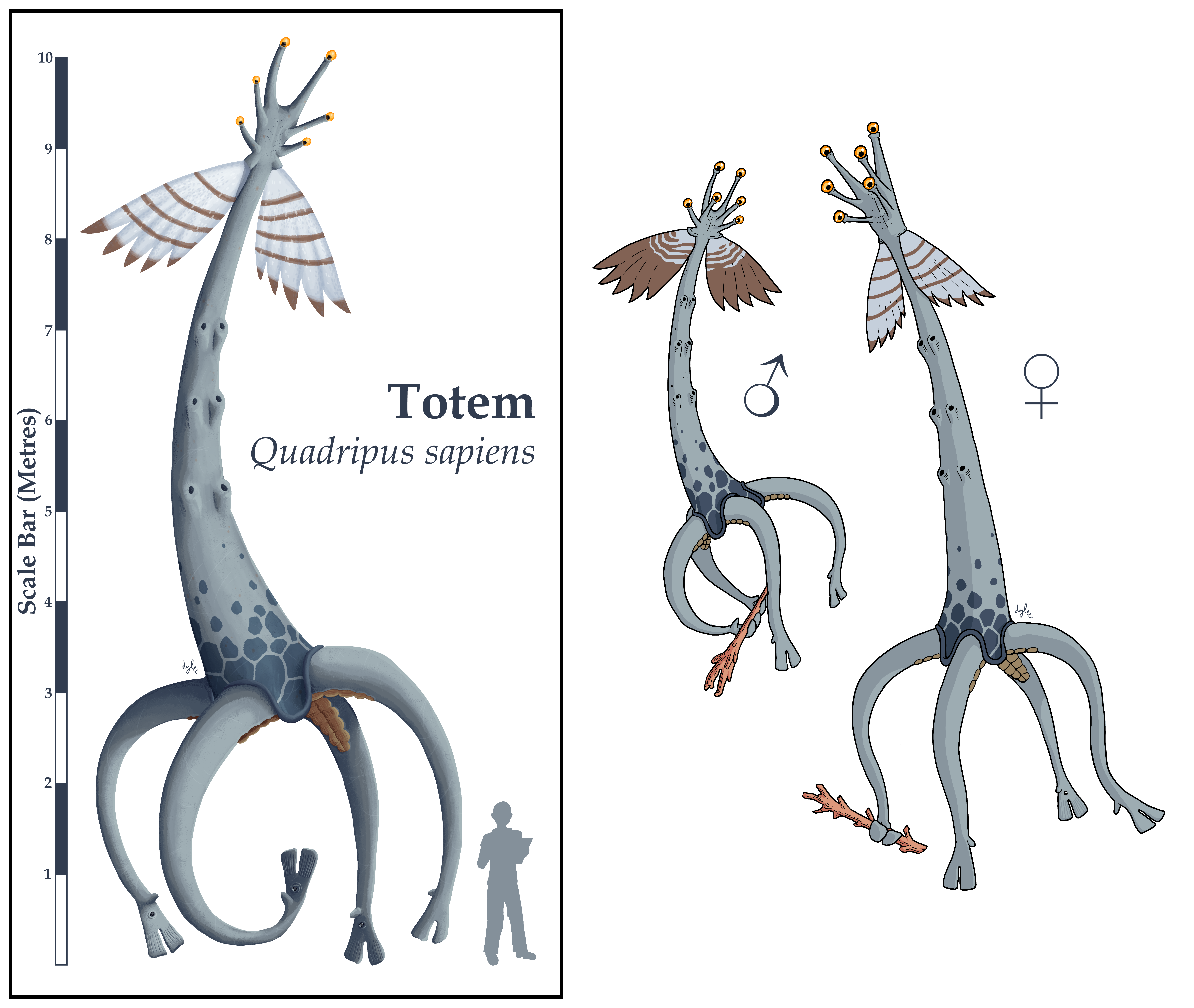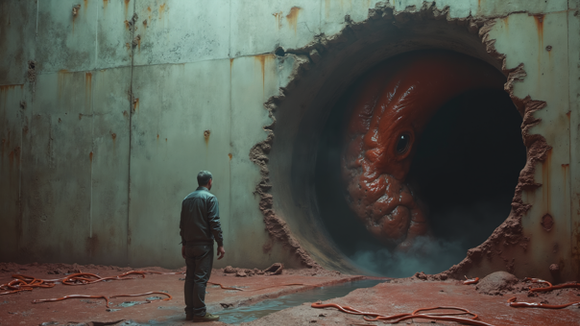HOME | DD
 Tree-Sparrow — General Anatomy of a Ferraphyte
Tree-Sparrow — General Anatomy of a Ferraphyte

#alien #anatomy #astrobiology #cerberus #evolution #exobiology #iron #life #plant #scifi #space #speculative #xenobiology #ironplant #maxivita #intestinopsa #ferraphyta #dolicha #extraterrestrial #sciencefiction #speculativeevolution #speculativebiology #speculativexenobiology
Published: 2022-05-21 18:15:33 +0000 UTC; Views: 5724; Favourites: 40; Downloads: 4
Redirect to original
Description
Here is an updated diagram depicting the ancestral anatomy of ferraphytes, or iron plants. These comprise large, photosynthetic tube worms that possess symbiotic algae in their plumes, and comprise the dominant flora on land on the exoplanet Cerberus.General Anatomy of a Ferraphyte:
Plume: the Plumes are the photosynthetic organs of ferraphytes. They evolved from the palps of ancestral intestinopsans and contain specialised, red-coloured algal symbionts. In most ferraphytes, the symbiotic algae are from the kingdom Aliophyta. These algae provide iron plants with energy in exchange for safety from grazers, constant light levels, and a supply of nutrients. Up to 90% of the energy produced by the algae goes directly to their host. Through this arrangement, both the ferraphyte and its symbiotic algae are mixotrophs.
Plumes are supported by a stiffened region known as the Plume Bar. This contains muscular tissue and a mutable tissue similar to cartilage that can rapidly change in stiffness. Projecting from the sides of the Plume Bar are feathery structures known as the Plume Filaments. These structures are thin and hollow, and contain the symbiotic algae. They also serve a respiratory purpose for the intestinopsan and allow gas exchange for the algae. The Plume Filaments have a high surface area allowing for efficient photosynthesis. In many species, Plumes are retractable into specialised Plume Pouches. This behaviour is an adaptation against grazers and stellar flares, allowing iron plants to quickly hide from danger into the safety of their Tubes.
Tube & Plates: iron plants get their name from their Tubes (also known as trunks). Tubes are comprised of iron oxide (Fe₂O₃) alongside chitin- and collagen-like materials. They provide structure for iron plants alongside protection from grazers or stellar flares, as iron oxide is reflective to ultraviolet radiation. The morphology of Tubes varies considerably between species. Some species have a single, uninterrupted cylindrical Tube. Others have jointed ones, or have Tubes comprised of many sub-sections. More complex Tubes are particularly common in species dwelling in stochastic environments (e.g., high winds). The appearance of Tubes may also vary, with some species using pigments to colour their Tubes (e.g., in aposematic species). Some species grow with their tubes buried in the sediment while others are emergent.
Alongside the tubes, other regions of ferraphytes may be protected in iron oxide Plates. In many groups of ferraphytes, the Plumes may have Oppercular Plates on their outside edge. These structures fit together when the Plumes retract into the trunk, providing a "door" that protects the organism from predation. Additionally, the Roots of ferraphytes may possess many Root Plates for protection against parasites, grazers, and diseases. Root Plates can also have complex morphologies, with spines or struts used to stabilise the worm in the sediment.
The Tubes evolved from excretory organs in ancestral intestinopsans. These ancestral species dwelt in volcanic marine environments high in toxic iron compounds. Thus, they evolved to excrete these compounds from their surface. This later became beneficial in allowing these worms to more successfully withstand stellar flares, and later to provide support and protection out of the water.
Fibrous Support: lightweight Fibrous Support material is present between the Tube and the living body of most ferraphytes. This material has a woody texture and is primarily used to help support the organism in Cerberus' high gravity. In many species, poisonous compounds are added to the Fibrous Support to deter parasites, boring organisms, and predators strong enough to crack open the Tube. A secondary purpose of the Fibrous Support is as an energy store (sugars and lipids) outside the body of the worm. In xerophytic species, water may also be stored here. Fibrous Support contains channels of tissue used to store/absorb stored nutrients and water. At the edges of the Fibrous Support are extra tissues used to generate the organism's Tube.
Ectodermis: the "skin" of ferraphytes. The Ectodermis is elastic and tough. In the Roots, this organ is specialised for nutrient and water uptake. At the top of the Tube, below the Plumes, a region of the Ectodermis may be Photosensitive, allowing iron plants to detect stellar flares and retract into their tubes before being harmed by the incoming radiation. In few species, specialised visual organs have evolved from this tissue.
Rain Gut: the Rain Gut is an infolding of the Ectodermis at the top of the iron plant, used to collect rainwater, and in some species as an additional store of gametes.
Reproductive System: the reproductive systems of ferraphytes are varied depending species. As with plants on Earth, a variety of methods are used for reproduction including wind- and pollinator-derived pollination. Here, a wind-pollinated structure is depicted. Sperm in ferraphytes has evolved into airborne pollen, which is dispersed into the air from the Stamen. Pollen may reach the Pistil, at which point it is absorbed and transported to the Ovaries to fertilise the eggs. The reproductive structures of most ferraphytes are ephemeral and may only develop during certain conditions or times of year. Once eggs are fertilised, they develop into spores (atrophied medusae), which exhibit a number of dispersal modes but most commonly are also dispersed through the air. Specialised structures may grow to aid in the dispersal of spores.
Excretory System: unlike ancestral intestinopsans, ferraphytes possess a well-developed excretory system. Metanephridia (kidney-like organs) filter the tissue fluid of ferraphytes to remove metabolic wastes. Some of this waste is transported to the symbiotic algae within the Plumes as fertiliser, while the rest is removed through Excretory Pores along the base of each Plume Bar.
Circulatory System: circulation in iron plants varies between taxa. In basal species, an open circulatory system is present, with a number of Hearts pumping tissue fluid throughout the organism. In more derived species, circulation is closed, with true blood vessels. A Primary Heart is used to pump blood against gravity, while many smaller Accessory Hearts pump blood back down towards the Roots. The blood of ferraphytes is a deep green colour when oxidised, as it contains a chlorocruorin-like respiratory pigment.
Nervous System (not shown): most ferraphytes possess a simple nerve net throughout their bodies. In few distinct species, specialised ganglia may be present in various locations for distinct purposes.
Roots: the Roots of ferraphytes are specialised growths of the body wall which serve to anchor the organism within the sediment and uptake nutrients and water. These organs are similar in many ways to the roots of vascular plants on Earth. In most species they are protected by Root Plates. The morphology of Roots varies between species, with many species able to partition niches based on the depth their roots grow, helping many species of ferraphyte coexist despite the harsh, dry conditions on Cerberus.
Mass of Body: as with most intestinopsans, the Body Mass contains muscles, the nerve net, and stem cells used in bodily repair.
Digestive Cecae (not shown): like their heterotrophic ancestors, ferraphytes possess Digestive Cecae. These cecae connect to their plume filaments. To supplement the nutritional requirements of the host, excess portions of the algal symbionts are frequently digested. The nutrients from this process are carried down the Plume Bars and into the Digestive Cecae. Unlike ancestral intestinopsans, however, these cecae are not the primary mode of nutritive distribution in these organisms, and they are relatively short. Instead, nutrients diffuse into the blood stream, and are distributed through these tissues to the rest of the organism.
More info about iron plants:
www.deviantart.com/tree-sparro…
www.deviantart.com/tree-sparro…


























